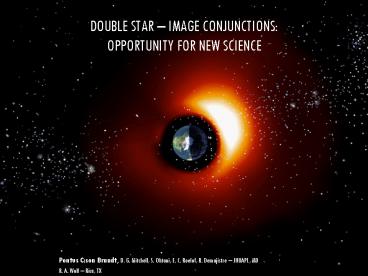DOUBLE STAR IMAGE CONJUNCTIONS: OPPORTUNITY FOR NEW SCIENCE - PowerPoint PPT Presentation
Title:
DOUBLE STAR IMAGE CONJUNCTIONS: OPPORTUNITY FOR NEW SCIENCE
Description:
DOUBLE STAR IMAGE CONJUNCTIONS: OPPORTUNITY FOR NEW SCIENCE ... way to image proton plasma. The hot plasma (ring current/plasma sheet) in the Terrestrial ... – PowerPoint PPT presentation
Number of Views:48
Avg rating:3.0/5.0
Title: DOUBLE STAR IMAGE CONJUNCTIONS: OPPORTUNITY FOR NEW SCIENCE
1
DOUBLE STAR IMAGE CONJUNCTIONSOPPORTUNITY FOR
NEW SCIENCE
- Pontus Cson Brandt, D. G. Mitchell, S. Ohtani,
E. C. Roelof, R. Demajistre JHUAPL, MD - R. A. Wolf Rice, TX
- M. C. Fok NASA GSFC, MD
2
OUTLINE
- WHY ENA IMAGING?
- WHAT HAVE WE LEARNED?
- MI-coupling at work
- WHY gt2 VANTAGE POINTS?
- CONJUNCTIONS
3
Charge Exchange
A magnetically trapped ion captures an electron
from a neutral hydrogen atom...
creating an energetic neutral atom (ENA) that is
no longer trapped.
4
THE IMAGE MISSION
- Lifetime 2000-2005
- 800 x 8 Re solar inertial orbit (more later on
orbit) - LENA 50 eV-10 keV
- MENA 1-50 keV
- HENA 10-200 keV (hydrogen) 50-180 keV (oxygen)
- FUV auroral imager (proton and electron aurora)
- EUV plasmaspheric imager. Images light
resonantly scattered sunlight scattered on He.
5
High-Energy Neutral Atom (HENA) Imager
Lead Investigator D. Mitchell, Applied Physics
Lab
6
STORM AS SEEN BY HENA March 31 2001 (60-119 keV
protons)
-40 nT
21 nT
26 nT
0730 UT
0830 UT
0930 UT
7
WHY ENA IMAGING?
- The only way to image proton plasma.
- The hot plasma (ring current/plasma sheet) in the
Terrestrial magnetosphere has proven to be more
dynamic than anticipated. - Need to measure global pressure on timescales lt
10-20 min. - All of the region 2 and probably a large portion
of the nightside region 1 current system is
PRESSURE DRIVEN.
8
MEASURED/COMPUTED QUANTITIES
SCIENTIFIC UNDERSTANDING
ENA
STORM, SUBSTORM DYNAMICS
PRESSURE
CURRENTS
MI-COUPLING
B-FIELD TOPOLOGY
DB (Biot-Savarts)
ADIABATIC EFFECTS ON RADIATION BELTS
9
(No Transcript)
10
(No Transcript)
11
(No Transcript)
12
(No Transcript)
13
(No Transcript)
14
(No Transcript)
15
(No Transcript)
16
WHAT HAVE WE LEARNED SO FAR?
- The morphology of the storm-time ring current
depends heavily on the ionospheric conductivity. - Storm main phase ring current peaks around
midnight. - Storm-time ring current penetrates always deeper
than geosynchronous. - Heavy ions (O) are energized dramatically during
storm-time substorms. - Storm-time substorm injections can have an
extreme local time extent (to noon).
17
(No Transcript)
18
MI-COUPLING AT WORK
- Old picture storm-time ring current peaks at
dusk, because thats where the Alfven layer comes
closest to the Earth in a dawn-dusk E-field. - New picture Wolf, 1980 Fok et al., 2001
storm-time ring current peaks at midnight.
Consistent with IMAGE results Cson Brandt et
al., 2002. - Mechanism
- The convectional E-field (dawn-dusk) try to force
Hall currents to flow across the terminators
(conductivity jump)?positive charge
build-up?skewing of potential pattern. - Probably some additional intricate effects.
19
SubAuroral Polarization Stream (SAPS) (Foster et
al., EOS and JGR, 2002)
20
WHY gt2 VANTAGE POINTS?
- ANSWER one polar vantage point and on at the
equator can resolve large-scale pitch-angle
distributions (PAD) for the first time! ? Effects
on all results discussed above. - Specifically is there a high-energy (100 keV)
component of trapped ions during storm main
phase? - Perigee passes with IMAGE and simultaneous apogee
passes with DSP will give essential information
on upper atmosphere interactions during different
phases of the storm/substorm. - Note tomography requires far more vantage points
than just a couple.
21
(No Transcript)
22
CONJUNCTIONS
JAN 2001
JAN 2002
JAN 2003
JAN 2004 Mostly equatorial vantage point
JAN 2005 Mostly polar
23
PAD AND VANTAGE POINTS60-119 keV hydrogen ENA
EQUATORIAL VANTAGE POINT Dst-54 nT
POLAR VANTAGE POINT Dst-71 nT
Note a factor of 2 stronger flux for equatorial
vantage point?Anisotropy2.
24
3rd (and 4th) CONJUNCTION ?
- NASA S/C TWINS launch in mid 2003.
- 2 ENA imagers in 2 opposing Molnyia orbits.
1000km x 7.2 Re. 64 deg incl. - Based on IMAGE/MENA design.
- H and O
- 1-70 keV
25
CONCLUSIONS
- At mid-2004 IMAGE apocenter will be at 30-40 deg
lat (southern hemi)?PAD resolved for first time!! - Later in 2005 IMAGE apocenter towards southern
pole. - Perigee-Apogee combinations essential for
detailed information on upper atmospheric
interactions. - Ring current see effects of magnetospheric
E-fields? in-situ measurements (E-fields and
particles) essential. Also for intercalibrating
DSP/NUADU and IMAGE/HENA. - Third (and fourth) conjunction with TWINS. Launch
in 2003.
26
LAUNCH END OF 2003?
27
(No Transcript)
28
(No Transcript)
29
R1 HIGH CONDUCTIVITY R2 LOW CONDUCTIVITY Sp
HIGH, SH LOW ? NORTHWARD E-FIELDS WE THINK.































